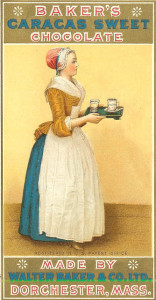 In January of 1919 an enormous tank of molasses on Commercial St. in the North End of Boston burst. This disaster spewed hundreds of gallons of molasses into the streets, killing and maiming nearly two hundred people and horses and moved entire buildings off their foundations. This is a famous story, at least one definitive book has been written on it. I will leave known history severely alone and tell a different story. A sweeter one – of Boston, molasses, sugar and chocolate.
In January of 1919 an enormous tank of molasses on Commercial St. in the North End of Boston burst. This disaster spewed hundreds of gallons of molasses into the streets, killing and maiming nearly two hundred people and horses and moved entire buildings off their foundations. This is a famous story, at least one definitive book has been written on it. I will leave known history severely alone and tell a different story. A sweeter one – of Boston, molasses, sugar and chocolate.
To do this some historical background is necessary.
Most of colonial America developed along a pattern, known as the Virginia model, of agriculture and extraction. Highly successful because land was fertile, cheap and plentiful. So was labor, mostly due to indentured and enslaved workers.
New England Farms grow rocks and children.
The New England colonies could not follow a model of agriculture and extraction. Labor was expensive because of available work on ships and at docks, and because the region’s thin rocky soils produced barely enough food to feed large families, certainly not enough to maintain a labor force that wasn’t needed anyway. This subsistence farming was the result of geology. From 30,000 to 10,000 years ago, the Wisconsin ice sheet, about three miles high, pushed rocks from upper Canada into New England rearranging everything in its way. Boston Harbor, the Blue Hills, Cape Cod, Nantucket, Martha’s Vineyard and Long Island, NY are the nearby, obvious result of this ice. The size and shape of the north eastern mountain ranges, and the dearth of native rhododendrons are a few others.
While the ice took away to soil, it left deep harbors (and a never-ending supply of field stones that decorate the sides of roads and foundations for most of the region’s houses.) But before we move onto sweeter things, there is one extractive thing the mother country needed very badly: New England hardwoods for ship building and tall white pines for ships’ masts.
Molasses??
In brief, he who can make a leak-proof ship, can make a barrel that doesn’t leak. And New England shipyards produced the best fitting, leak-proof barrels and barrel staves in the colonial world. This was good because although the British Colonies in the Carribean tried to make sugar into cones from the cane they grew, the tropical heat caused the raw sugar to return to its drippy, syrupy state. Fortunately for the sugar producers of the Caribbean, barrels of dried cod, quickly returned to Boston with drippy molasses that was refined into sugar in the reliably cool New England town of Boston.
So Revere Sugar, Baker’s and now Taza chocolates, and of course Lindt and NECCO are not coincidentally located within reach of Boston, neither was the molasses tank that exploded on Jan 15, 1919, but for that you need to understand how molasses was made into smokeless gunpowder for use in WWI, and I’d rather make cookies.
Interesting fact. Dried cod is still used in many Caribbean dishes, a leftover from colonial times.
